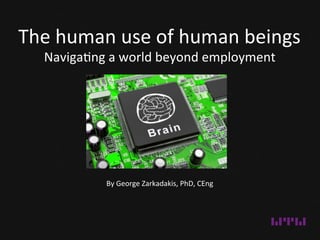
The impact of AI on work
- 1. The human use of human beings Naviga1ng a world beyond employment By George Zarkadakis, PhD, CEng
- 8. The end of work?
- 9. The fear is old June 29, 1955, Punch Magazine.
- 10. The story so far AI (1960s) AI (1990s) AI (Now) ENIAC (1946) The AI “Winters” Lighthill report, DARPA cuts 5th Gen fizzle
- 11. State of play Cogni1ve Automa1on Time Now Recogni+on intelligence Cogni+ve Intelligence General Intelligence (?)
- 12. Enablers of work automa1on Robo+c Process Automa+on Cogni+ve automa+on Social Robo+cs TASKS Rou1ne, High-‐volume Non-‐rou1ne, crea1ve Rou1ne, collabora1ve MATURITY HIGH EMERGING MEDIUM IMPACT MEDIUM HIGH HIGH
- 13. Scalability: AI as a pla`orm AI interfaces (Natural language conversa1ons) Machine Learning
- 14. The automa1on of jobs Source: The Future of Employment, by C. Frey and M. Osborne 47% of jobs will be fully-‐ automated in the next 10 years
- 15. Source: McKinsey Interim report on automa1on of jobs, Nov. 2015 45% of job ac1vi1es can be automated +AI = 58% of job ac1vi1es can be automated 60% of jobs can have 30% of their ac1vi1es automated Hello Jane, you look great today! How can I help you? Automa1ng tasks (not jobs) 5% of jobs will be fully-‐automated
- 16. Country and educa1on level variability 9% of jobs will be fully-‐automated Source: Arntz, M., T. Gregory and U. Zierahn (2016), “The Risk of Automa1on for Jobs in OECD Countries: A Compara1ve Analysis”, OECD Social, Employment and Migra1on Working Papers, No. 189, OECD Publishing, Paris.
- 17. Automa1ng the marke1ng analyst Source: WTW Research, March 2016 $20,000 $123,000
- 18. Previous impacts: Automa1on means less work… … but not less jobs 50% increase in total number of employed people Wage rise 2.23% faster than infla1on
- 19. Automa1on = higher produc1vity… …flaoening out around the end of ‘00s
- 20. Source: Wells Fargo The big slowdown: Not enough automa1on?
- 21. Source: Boston Consul1ng Group Manufacturing costs are on the rise…
- 22. The rising cost of “cheap” labour
- 23. The decreasing cost of robots
- 24. The Solow Paradox You can see the computer age everywhere but in the produc1vity sta1s1cs.
- 26. The change is on 2nd Industrial Revolu+on “The assembly line” Features: § Underpinning for Coase’s theory of the firm § Companies as social ins1tu1ons § Organiza1on of work into jobs § Jobs as careers 3rd Industrial Revolu+on “Nikefica1on” Features: § Technology enablement and the web § Companies as the nexus of contracts § Streamlining of jobs to enable outsourcing 4th Industrial Revolu+on “Uberiza1on” Features: § Mobile, sensors, AI and machine learning § Companies as pla`orms § Disaggrega1on of work into ac1vi1es § Talent on demand 1900s 1960s-‐1990s 2000s-‐
- 27. The 5 Forces of Change Source: CHREATE Consor1um Social & Organiza.onal reconfigura.on A truly connected world All inclusive, global talent market Human & machine collabora.on Exponen.al paCern of technology change 1 2 3 4 5 • Work Automa.on (RPA, CA, Social Robo.cs) • Blockchains • 3D prin.ng • IoT Technological Empowerment • Short term • Agile • Skills-‐based • Networks • PlaVorms Democra.za.on of Work
- 28. Possible futures LOW Democra+za+on of Work Technological Empowerment HIGH HIGH LOW Work Reimagined “UBER” Empowered Current State Today turbo-‐charged 1 2 34 Source: CHREATE Consor1um
- 29. A shared economy for talent Company A Company B Company C Company D Shared talent pla`orm AI-‐enabled IT HR CS
- 30. Transformed jobs: A more humane doctor Proficiency role (now) Pivotal role (future) Doctor Performance Doctor Performance Pa1ent Sa1sfac1on Pa1ent Sa1sfac1on AI -‐ Enabled As cogni1ve automa1on gets beoer with diagnosis human doctors (a “proficiency role”) can spend more 1me with pa1ents, becoming a “pivotal role” in healthcare systems
- 31. New jobs created Data, Talent & AI integrator Virtual Culture Architect Robot Trainer Cyber Ecosystem Designer AI Ethics Evaluator
- 32. A new cyberne1c rela1onship Second-‐order cyberne1cs in the era of machine intelligence Humans and machines working together: machines managing complexity, humans providing crea1vity From knowing what you do not know and searching for it …to … …not knowing what you do not know and having “someone” to help you discover it
- 33. Cyber-‐physical Systems & Industry 4.0 From hierarchies to networks CPS-‐based automa+on Field level Control (PLC) Level Process Control Level Plant management Level ERP Level Automa+on hierarchy
- 34. Zero Latency Enterprise Company Organisa1on Enterprise Systems Enterprise Applica1ons Enterprise App Integra1on Data Store In a real )me, zero latency enterprise, informa)on is delivered to the right place at the right )me for maximum business value.* *Defini1on of ZLE by Gartner
- 35. The Responsive Organisa1on An agile, client-‐facing, innova)ve organiza)on that con)nuously learns and op)mizes talent and technologies in order to deliver superior products and services. Machine Intelligence Applica1ons People Networks Business Systems Learning & Conversa1ons Business Applica1ons Business App Integra1on Virtual Data Store
- 36. People Networks: reinven1ng business organisa1on • Self-‐organised ad hoc teams • Build-‐in discovery from design to customer service • Scaling Agile • Cross-‐market & Cross-‐exper1se • Collabora1on pla`orms • AI enabled UI/UX • Predic1ve analy1cs
- 37. Future-‐proofing
- 38. Transforming business with work automa1on Source: “Lead the Work” by R. Jesuthasan, J. Bourdeau, D. Creelman Assignment Organisa1on Rewards • Self-‐contained • Unlinked • Exclusive • Stable • Deconstructed Tasks • Dispersed • Project-‐bound • Constructed Jobs • Anchored • Employment-‐Bound • Long-‐Term • Collec1ve and consistent • Tradi1onal • Permeable • Interlinked • Collabora1ve • Flexible • Short-‐term • Individualised and Differen1ated • Imagina1ve AI enabled
- 39. Geyng there: Scaling Agile organisa1on Apply agile prac1ce across the organisa1on hop://crowdmics.com/ hop://crowdmics.com/ INNOVATE DELIVER VALIDATE UNDERSTAND
- 40. Geyng there: digital engagement Apply Next Genera1on Integrated Digital Engagement Model (IDEM) for the digital transforma1on of work Behavioural Modelling Human-‐ machine conversa1ons AI Interface Data Worker experience Human-‐machine collabora1on
- 41. Geyng there: machine intelligence for EX Build the machine intelligence layer of the responsive organisa1on
- 42. Thank you George Zarkadakis, PhD, CEng @zarkadakis
